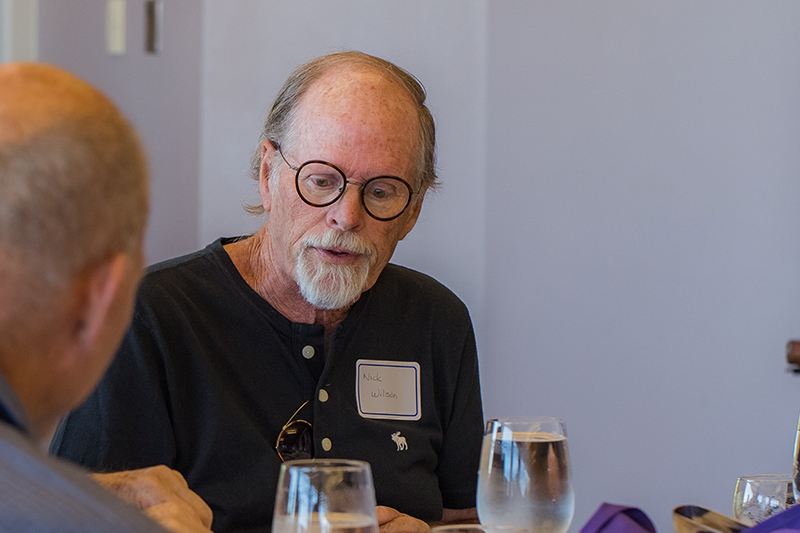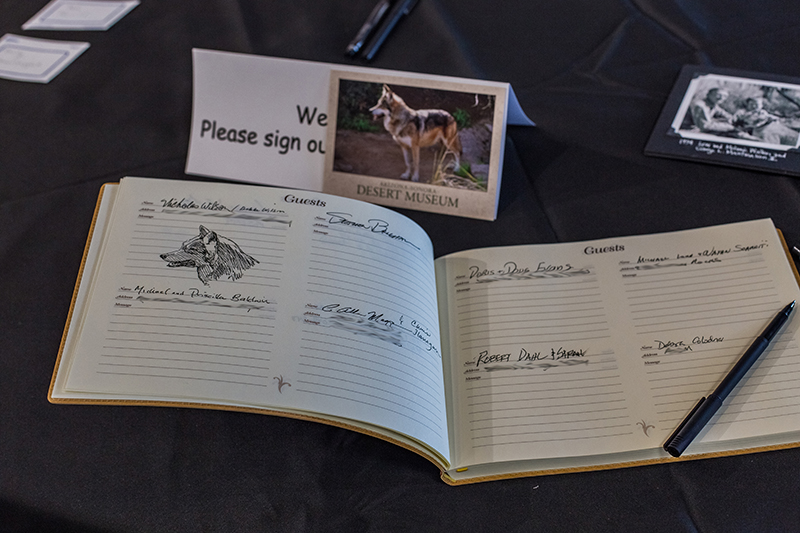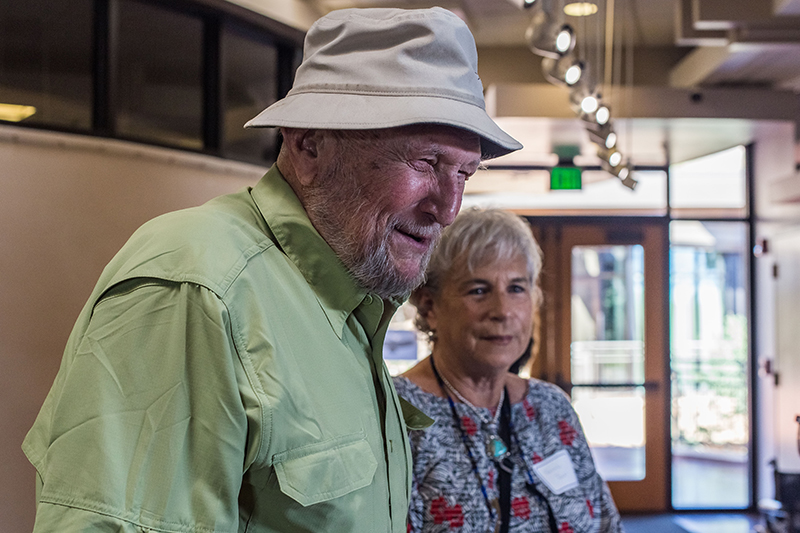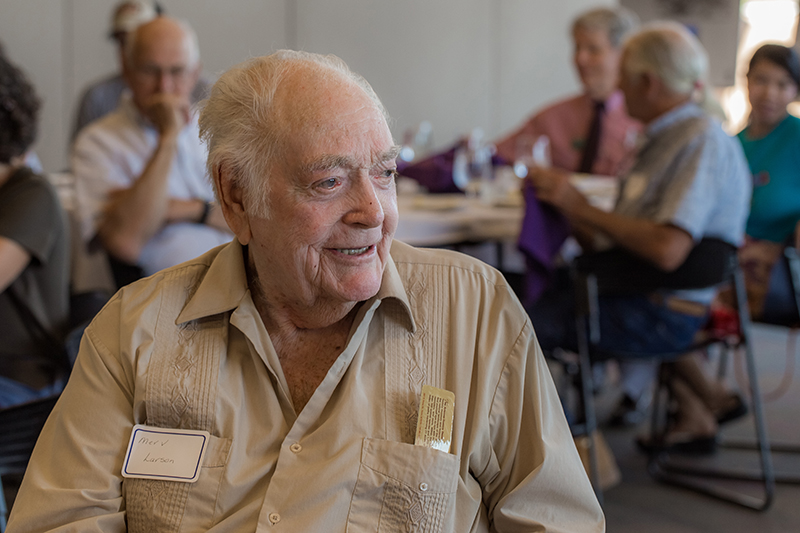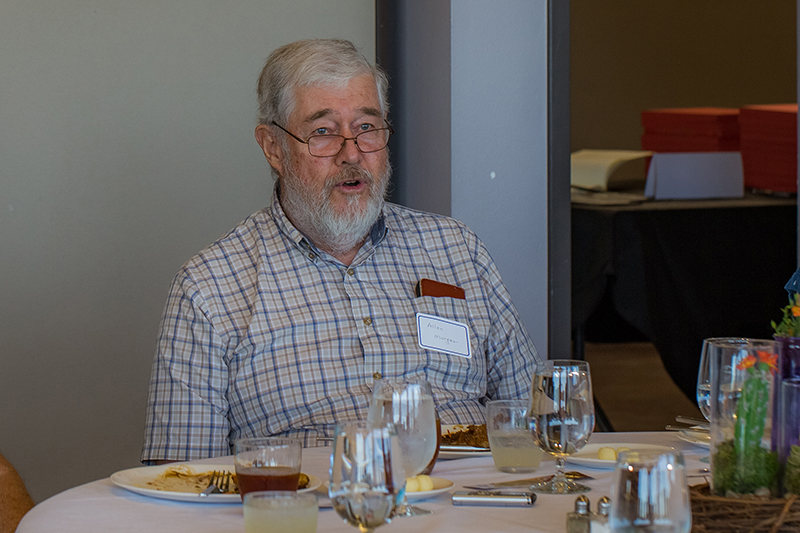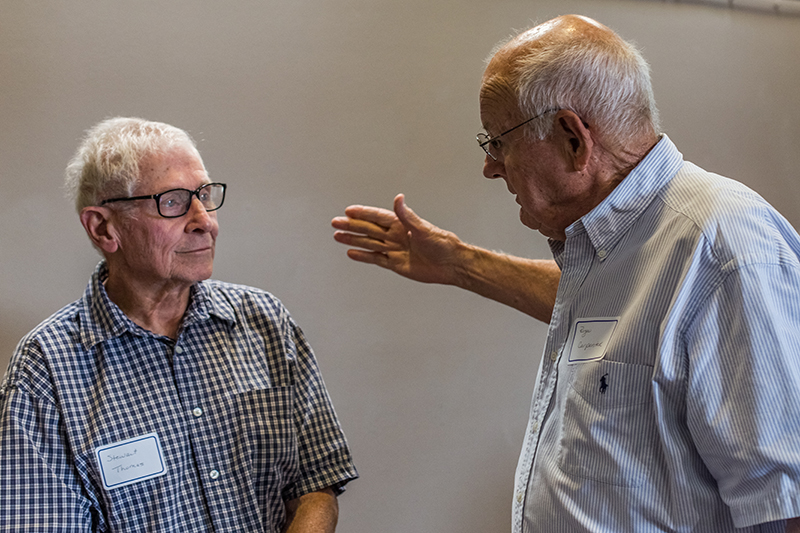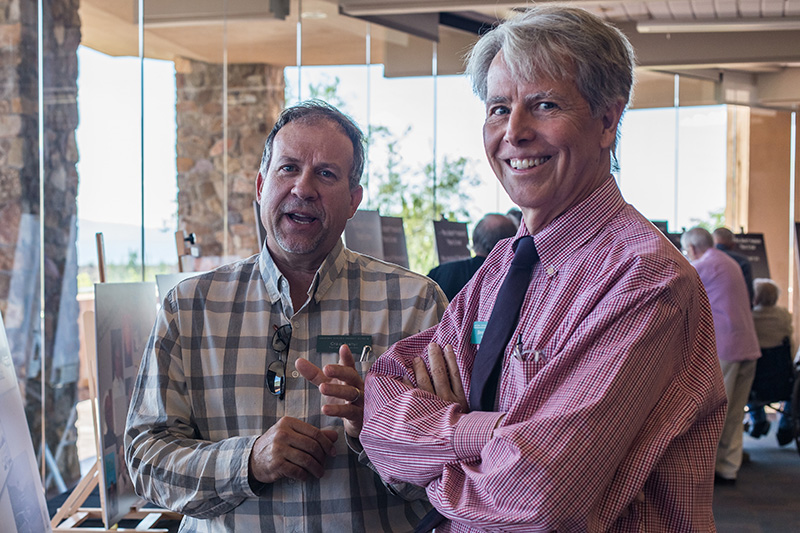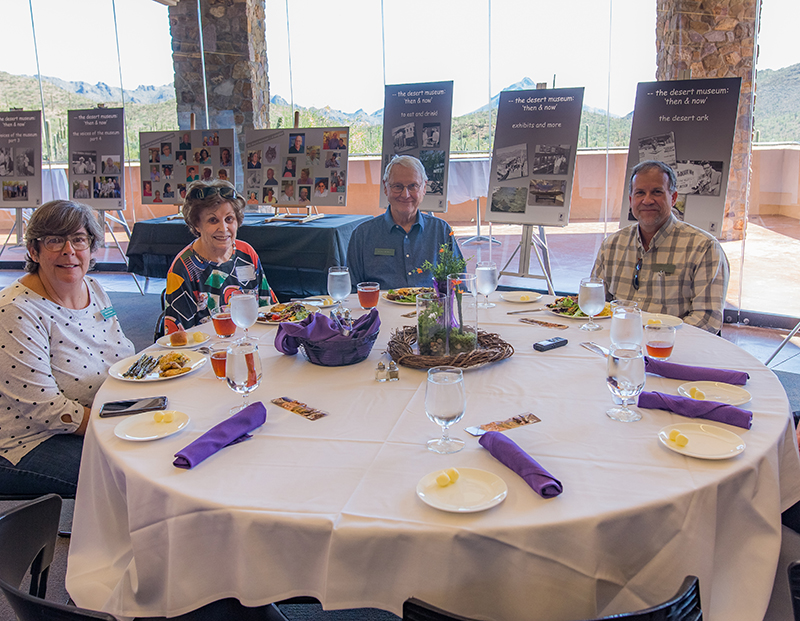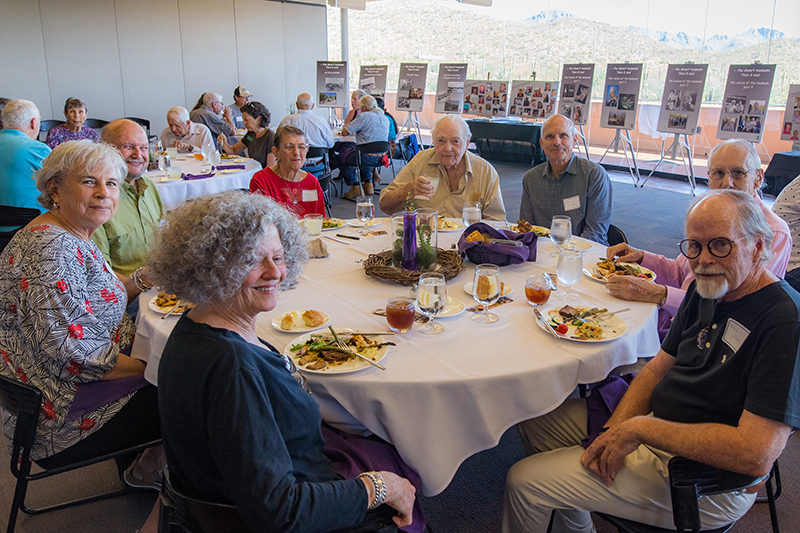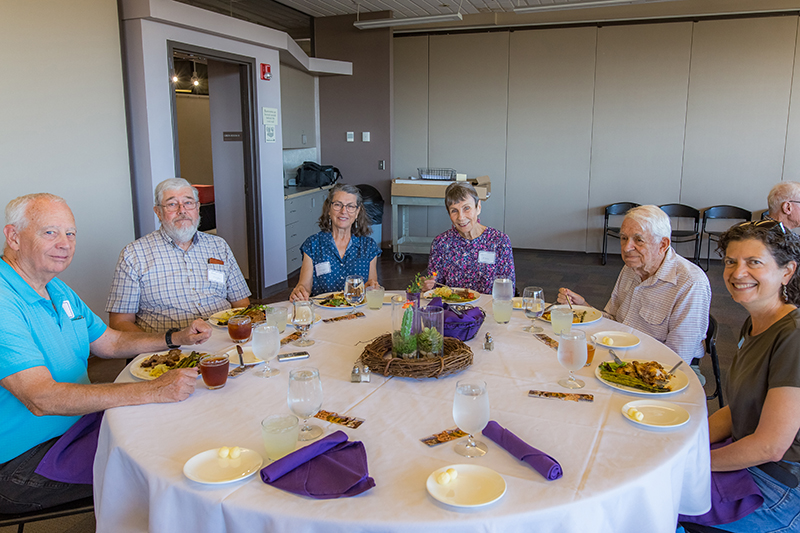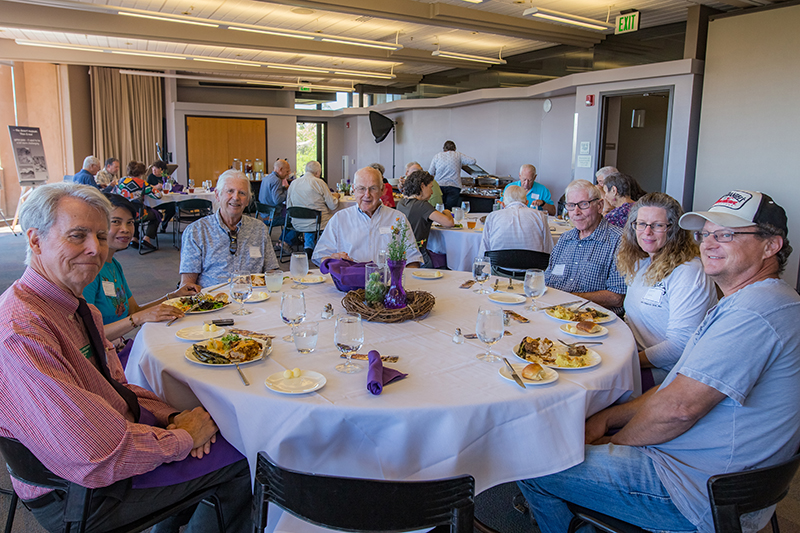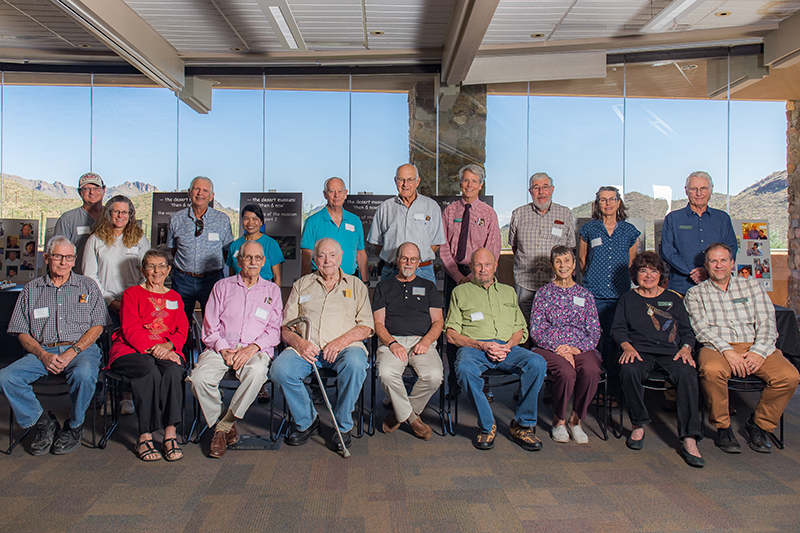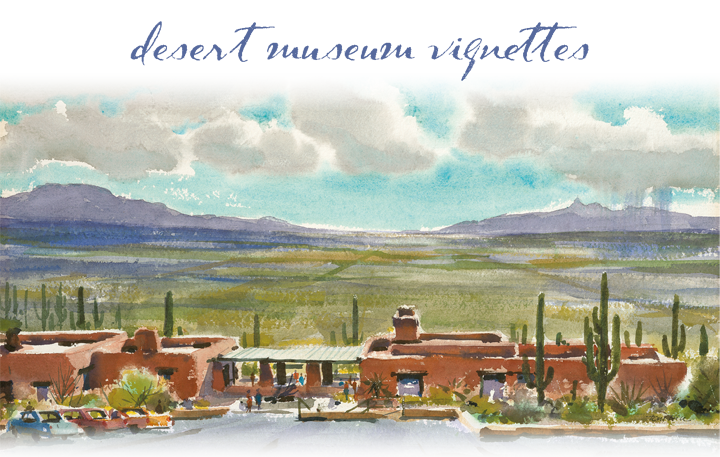
Celebrating The Desert Museum’s Beginnings —
and the Special People Who Worked Here
Introductory Remarks
- Kevin Bonine, Chair of the Board of Trustees:
- On behalf of the Trustees, thank you so much. Thank you for today, thank you for the future and thank you for everything you’ve done in the past. The legacy of ASDM is critically important today and for tomorrow. Thanks to the visionaries from decades past, and to those dedicated to realizing the ASDM mission.
- Steve Brigham, Vice-Chair of the Board of Trustees:
- I can’t tell you what an honor it is to meet some of you. I’ve seen the names — I’ve heard about you — and now to finally meet you. It’s such an honor. I haven’t been with the Museum certainly as long as many of you but I did serve on the board back in the 90s and had so much fun, I decided to come back and serve on the board again. How many places can you be involved with that when you mention in public that you’re involved with the Museum you just get this look — ‘Wow what great place. You’re such a lucky person to be involved in that organization.’ Thank you for having me here to join you for lunch. I look forward to talking with a few of you and getting to know you a little bit better. Thank you.
Attendees — both former employees and guests —were asked to introduce themselves and talk about their early visits to the Museum.
John Woodin
I first visited the Museum when I was 4 or 5. My Dad was Bill Woodin and so I spent a great time of my childhood here wandering around. I spent a lot of time with Merritt Keasey. I spent time at the Gift Shop — trying to buy candy. Those are some of my best memories.
Carlos Nagel
In 1974, when I left the directorship of the Museums of New Mexico, I received a grant from the Weatherhead Foundation in New York. So, what happened is they gave me a grant to come to the Desert Museum for four years and set up the Mexico program. I came and met all these wonderful people, many of whom are here. Plus I got to travel everywhere in Mexico — every state in Mexico. So I came to this very special area of the world which is the borderlands — where two countries came together which were very dissimilar, but because of family relationships and economic relationship we really formed a very special place in the world. We live in a very special place in the world, where we have 30% or more of the people of Mexican ascent -- not descent. And we have this extraordinary place of businesses and professionals and educators and what not. So we are very privileged to live in this part of the world — extraordinarily privileged. Every day we should give thanks for the privilege of living with this kind of weather and this kind of environment.
Nick Wilson
I was the artist here in 1970. Sheridan Oman had just left the Museum and I was able to do some of the artwork and some of the exhibits which are still on the grounds today. Some are fifty years old — with lots of dust on them. I was twenty-one at the time. And I learned everything I know after that. It’s great to be here.
Debbe Wilson
I came out the first time in 1992 and love it. I spent a lot of time running around and enjoying the exhibits. There’s been a lot of nice additions over the years to the Desert Museum. And it’s always a joy to walk around. We enjoy it.
Sarah Dahl
I first came here in the early 1990s. The Museum is just a fantastic place. It’s wonderful to come out and just wander around. My favorite is the Spring when all the cactus are blooming. So I come and I take pictures of all the cactus and just enjoy the view. It’s such a fantastic place. It’s wonderful.
Bob Dahl
I came here in 1972. I had been in charge of exhibits at the Portland Zoo which at the time I went to work there it was a lot of concrete pits that were painted with colors that show up good on Kodachrome film — that was the criteria. I started proposing some radical changes and our director there invited Merv up to visit and he told me ‘your ideas aren’t as new as you think they are. Here’s a guy who’s been doing it for years.’ Anyway Merv came up and we hit it off real well. I remember his comments when I took him out in the forest —he told me ‘all this green stuff just confuses me.’ Anyway we got to know each other and I came down here for a visit and just loved it. And — my memory might be selective, but — I think I remember Merv saying ‘you’re wasting your time up here. I need a Curator of Exhibits.’ And it didn’t take me very many minutes to make up my mind and I came down here in 1972 and became the Curator of Exhibits and it’s been a wonderful ride. I just got hooked on the desert — completely hooked — from a mixed conifer forest to the Desert Museum down here was quite a change. I remember feeling like it was kind of like being on Mars — until I went to Baja where I decided there was a Jupiter. Anyway I had many pleasant years down here, we built the Geology Building and modified a lot of other exhibits and then I was asked to come back up to Oregon by an old friend of mine who I worked at the Portland Zoo with — and he invited me up — he’d gotten a grant and some land — we designed and built the High Desert Museum in Bend, Oregon. And then ever longing for the desert, I came back down here. I tried to leave twice and it didn’t work. I was like a yo-yo — I come back here. I’ve been here twenty-six years now this time around. And I still just love it — the desert and I love all the things that the Desert Museum taught me. I’m just going to finish up with — they asked me to come back here — and I couldn’t believe it. I was hired to work with a guy who’s job I used to have — and I was writing an interpretation for the different interpretive signs around the Museum. And finally I retired from here — back I think it was 2003 and anyway — I still live in Tucson. I love the desert. I don’t move around a whole lot. Nick asked me — ‘where are you living now?’ I said ‘I haven’t moved a gol-darned inch for twenty-six years which is the longest I’ve ever lived anywhere. So anyway it’s real good to be here and I look forward to talking with all the other ‘old-timers’ here. Thanks.
Peggy Larson and Merv Larson
We showed up here the day after Christmas in 1953 and thanks to Bill Woodin, John’s dad, Merv had a chance to come here. So we lived up in the little house which is now the IAC headquarters for six months. And we thought we didn’t like the desert and so we moved back to California — and two weeks later we said — ‘we should have stayed in Tucson’ and so when we got a chance, we came back again — and we’ve been here ever since.
Craig Ivanyi
So when I first came here — it was probably 1977 — never having any idea that I end up working here. My father loved going to museums and as kids we always regretted that he liked to read everything everywhere. So we were at places like this for many, many hours as he read every word. And of course when you become a museum professional you really appreciate the people like my father because you hope they read what you put out there. So I actually came out here in 1984 as a volunteer. I was a student at the University of Arizona and I knew I needed something besides a degree to get a job somewhere. And my wife at the time, said ‘I think they take volunteers our there’. So I applied to be a volunteer in both animal departments. And only one was taking volunteers and that was the Reptile, Amphibian, Fish and Invertebrates Department. And so I started in that department. Had no experience working with animals like that —no particular affection for animals like that but certainly that changed over time. And so I worked at that for a long time. Since then I’ve had twelve different positions — all animal-related — and then of course being Curator and Director of Collections and now I’ve been Executive Director for nine and a half years. So I’d just want to add to the Opening Remarks if I could — since being here as long as I have, I have an appreciation for everything you guys did to set this place up to be what it is — and when we work with Board members like Michael and we’re talking about the future of the Museum — we’re constantly reflecting back on the words of the founders — and all the people who have been here. And they’re just as relevant today as they were when this place opened. Sadly, the mission is just as important and quite often people don’t seem to understand. I would hope that after almost seventy years of being here, we could say ‘job done. Let’s move on to something else.’ And sadly that’s not the case. It’s needed as much now as it’s ever been needed before. And we’re just really fortunate as Carlos said earlier to be in this environment. I watch people from other countries come to this view and they just look — this is the exotic for them. It’s something that so bizarre and different that it just draws them in. So somehow I ended up finding a place at this organization and they haven’t kicked me out yet. I’m sure it will happen some day but I’ve just been really fortunate to be here and to have so many opportunities to grow with it.
Michael Baldwin
I’ve been a Trustee for about fifteen years. The main reason that I am here is this lady here, Priscilla Baldwin. She’s the founder of the Art Institute in which building we sit — and that program has drawn now thousands of art students to the Desert Museum for a program that which — in a year — we’ll probably hit fourteen or fifteen hundred students this year. And they will take 150-160 classes in all subjects from photography to scratchboard — and all to the mission of the Desert Museum. Through art, people come to appreciate what it is that they’re involved with the subject matter. You cannot do detailed art without becoming enamored of the subject. And that creates naturalists and conservationists. And the motto of the Art Institute is ‘Conservation through Art Education’ and that has been going on since the first class — in 1998. We had eight students in a workshop and in the current Spring semester we had 804 students — some twenty-one years later. So the program continues to grow, drawing people to the Museum and has become a very viable and an important part of the Museum. And we all have to thank Priscilla for that because she is the founder and from that we have traveling shows — Vanishing Circles which is the Museum’s collection of paintings by well-known artists — and that travels. We cannot take saguaros and animals with us on the road to show the Museum’s message of learning to love your environment. We can’t take that stuff with us but we can take the pictures -- the paintings — and have them in exhibits. We’ve had them in several cities and two exhibits in Mexico. So, it’s a going concern. We moved to Tucson full time in 2010 but we’ve been coming here since 1996 and this is — (we’re) originally from Hawaii — and this is the best place we’ve ever lived and the Museum’s a big part of that.
Marie McGhee
I’m Marie. I’m really new. I’m very fortunate to work with Priscilla — actually I run the Art Institute now and I’ve been doing it for about a year. I run classes — and feel strongly about our mission of ‘Conservation through Art Education.’ That’s our focus and we continue to work that way.
Liz Kemp
I’ve worked here almost fourteen years now. My title is Webmaster, but that doesn’t completely explain everything I do. I also take photos. I’m originally from England. You can probably tell. It’s a long story on how I ended up in Tucson, so I won’t tell you that. But I have no intention of ever leaving. I mean — why would you leave?
Debbie Colodner
I oversee Conservation, Education and Science at the Museum. I took Doris’ place — maybe filling her pinky toes, that part of her shoes. And I don’t know if you all know how amazing this place that you created is. I don’t know if you know how well respected it still is among other zoos and museums. I don’t know if you’ve followed the Top 10 rankings that this place has gotten as a zoo, as a botanic garden, as a museum — Top 10 in the world. We’re there with the Louvre and the Getty. It’s just incredible what you created. There are other places out there that are trying to steal, and we would share it if we could. If we knew what it was, we’d probably try to sell it. The secret sauce that you created here — I don’t know if you know what it is. There’s going to a conference of zoo people coming in the Fall to talk about the Museum as one of the models for the future of zoos. There’s something here that connects people to nature and to animals better than anywhere else in the world that you can visit. So thank you creating it.
Doris Evans
I was Doris Reddy when I worked here. I started here in 1969 as a Summer class teacher. I was a teacher in TUSD. I replaced Chuck Hanson as the Summer class teacher, but then he got the job as Curator of Large Animals. So I got the Summer Class job and did it for a couple of years and more and more kids were coming out to the Museum — and more classes — some are wonderful — some not so much. So Merv said ‘I think we need something’. And so we needed to start up an Education Program and I happened to be in the right place at the right time. And Merv hired me — and we said —‘now what do we do?’ So we put together the greatest trip. He knew everybody in the zoo world. So we went to — one day to San Diego, the next day to Los Angeles, then San Francisco, then Portland and then Vancouver. And each day people just piled on me all the information they had on their volunteer programs. So I came back here with this pile of stuff. So the only thing I could think of was a Docent Program. So we started that. And I was here until 1978.
Chris Flanagan
I went to the University of Arizona and I was trying to think — when did I first come here? I first came to the University in 1968 so it had to be 1970/1971 — something like that. Anyway, I’ve been a fan ever since. And the only thing I can add is that I was asked to contribute to a chapter in a book called Public Garden Management. I used to be in Public Gardens. I got to feature model gardens around the U.S. in terms of how they serve the public. And I chose the Desert Museum. That was when Rick was here and I worked with Rick to get the pictures. And I wrote an essay surrounding how the Desert Museum fit the model of a Public Garden Museum. Because at that time, most public gardens didn’t consider themselves plant museums. They considered themselves Public Gardens which were a completely different thing. So, I’ve been really aware of ASDM for years and now learning a lot more — so, thank you.
Allan Morgan
I came to the Desert Museum first about 1968. We were living in Colorado at the time and we would come down Spring Break with the kids, camp over at Gilbert Ray (campground), and we would come over daily because I was a freelance wildlife photographer, and this is the place where the wildlife was. And it was really easy to photograph them. Thanks to all the work that people had done before making all those wonderful exhibits and natural habitat exhibits. So then, in 1975, I was here and this guy wearing a sort of work shirt and a hooked-beak of a nose tapped my on the shoulder. I was in the aviary — and he said ‘there’s a woman coming here from the University of California she was going to photograph roadrunner behavior. Would you like to sit in?’ — because he saw I had a big lens. And I got to know him — and that was Chuck Hanson — and I miss him. And because of Chuck I got a job at the Desert Museum and became the photographer and videographer. Preceding me in that position was another really fantastic guy called Frank Tinker. He did P.R. and photography and I don’t know if you know this, but he — a character representing him was in the movie ‘Unbroken’ about Lewis Zamperini when he was captured by the Japanese along with Frank — and he — or Frank’s character — appears in the movie. So if you get a chance to see it. Tinker’s in there. So, I was here for four years and there were a series of events when a number of people left. I stayed on for a little bit, to build up the coffers, and went back to free-lancing. And since then, I’ve done a lot of traveling. I guess I must have had a water deficit being here because I did a lot of work on ships — in Baja, other parts of the world, South America — spent nineteen seasons going back and forth to Antarctica. So the Museum was a wonderful introduction for me — a recovering electrical engineer — to get into the world of nature. And I learned so much here from many of you folks and folks who aren’t here now.
Bob Perrill
I was working in Rocky Mountain National Park and one of the Summer rangers up there was a winter ranger down in Tucson Mountain Park and I got to know him. And he pulled out a brochure on the Desert Museum and said ‘you need to go down there’. So I came down here and when I drove over Gates Pass I just totally fell in love with the place. Walked into the office at the Desert Museum, asked for a job — and a gentleman by the name of Merritt Keasey was there. He was the Curator of Small Animals at that time. And he walked me around — and there were no positions available. So they went over to Dick Blazer who was the Head of Maintenance. And they created a position for me, three days — custodian and two nights — nightwatchman. So, my introduction to the desert was cleaning toilets but also walking around here at night — and coming in and all of sudden having the whole place to yourself at night. It was an incredible experience. And a couple of months later, one of the guys in the plant department had allergies and he decided he couldn’t do it so I switched places with him. And so I stayed in the Plant Department from 1970 until 1985. And I became the Assistant Curator of Plants there. And it was such an incredible experience — many trips down into Sonora, Mexico and Baja California. And when I left the Desert Museum, I became a biological consultant all over the Southwest, doing endangered plant and animal survey work. And started a little nursery called Boojum Unlimited. And so I’ve been growing Boojum trees. I’m not growing them from seed any more because it takes a long time for them to grow. I still have about 300 plants. It’s been a really incredible journey and no other place in the world I’d rather be. And I thank so much the people who were working here at the time and the people that have come and gone. And thank you for having this opportunity for us to get together.
Roger Carpenter
I first came to the Desert Museum in the Winter of 1952 and I think that perhaps Bill Carr (I never called him Bill). But I think Mr. Carr somehow knew my parents and we were talking to him on the front porch and my mother said — I was in high school and I wanted to be a herpetologist then — and my mother said to him —‘well Mr. Carr, Roger would really like to have a job here.’ So he said, ‘Ok’ — he can start in January.’ So I started in January of 1953 and it was a great job. I got to clean the javelina cages. I earned $7/day. I worked weekends all through college — and full-time in the Summers — and had some good times and people who worked there at that time — including Stew Thomas. When I graduated, I went to grad school and had a career in Zoology in California. And when I retired I came back here. I’m a Tucson native and we live just on the other side of Gates Pass Road. As close as we are, I don’t get out here frequently enough. When I was working in those days, I used to ride back and forth to work with Bill Woodin. And it was really fun. The Museum has obviously grown enormously since 1953. My last two years that I worked here — ’56 and ‘57 — on weekends, I’d drive in and pick up the ticket taker Bob Morgan and he and I were the only employees on the grounds on the busiest days of the week—Saturday and Sunday. Lew Walker was up there at the Stables house — as an ‘official’ person. But I did everything else — fed all the animals, cleaned the 1.2 toilets/bathrooms. Thawed meat for the animals for the next day and fed them white rats and snakes and a really good time. And I’m back here now and I’m really glad to be back.
Michael Lord
I worked with Bob in the Exhibits Department in the middle 70s for a number of years. I built a lot of exhibits in the wet cave and the dry cave and numerous other projects. And my memories of being here — and that terrific cave project was going on — and that was the most amazing for me — not only the artificial rock but all the things associated with it. Of course under Bob Dahl’s tutelage, things were chaos. I still remember a couple of staff meetings in the Exhibits Department when I really wasn’t sure what we were talking about. But anyway then I morphed into a building career and my wife Mayan and I now run the Crickethead Inn up on Picture Rocks Road. And we have a one-upper for all at the Desert Museum. We have a lot of guests who say they see more javelinas at our house than they see at the Museum.
Mayan Suarniti
I like the Desert Museum. I’ve been here for fourteen years. I love the flying raptors, the hummingbirds and the gallery at the Museum.
Steve Brigham
I will tell you that I’m a fourth generation Tucsonan, but had the misfortune of growing up in New England. So I spent winters in New England and Summers in Tucson and it wasn’t until I was twenty-three years old, working at a large architectural firms in Boston and reading a book about a professor here and realizing that there’s a School of Architecture in Tucson, Arizona. And finally I figured out how to get back here full-time. So that was my connection here and haven’t regretted it and love the Summers here. You know people try to get away during the Summers. But Summers for me are magical. I love coming out to the Museum especially in the Summer to see what’s happening. So thanks for all of you — and what you’ve done to make this place special. It’s an honor to serve as my second term on the Board of Directors. So thank you.
ACW: The next gentlemen brings everything full circle because we have the tales of the 50s/60s/and 70s and yet what’s one of the newest projects that’s on the grounds? — Pack Rat Playhouse. This gentleman designed and built it.
Troy Letwak
I’m here today with my father-in--law but I was privileged enough to do all the steel work and most of the designing of the Pack Rat Playhouse. It was such a pleasure working with your employees. They were so easy to work with, so talented. It’s the biggest project I’ve ever done and I wouldn’t change anything. It was wonderful.
Suzanne Letwak
I’m here with my Dad who started working here in the 50s. My mom used to volunteer here. And I remember coming here when I was four years old or so. I’ve spent many years watching this place grow and I definitely have a strong love for the desert.
Stewart Thomas
I started out here in the Summer of 1954 — through 1965. The only people here when I started were Roger, Peggy Larson and Merv Larson. Bill Woodin was the Director. Lew Walker was the Assistant Director. And Merv was in charge of everything else. 25 people — it was a great crew. I think the basic concepts of the Museum from Bill Carr and Mr. Pack being implemented by Bill Woodin and Merv a lot of Museum exhibit techniques were developed and the Tunnel built. Merv was so encouraged by the success of the Tunnel that he built a bomb shelter in his house. And Friday and Saturday nights we had a lot of poker games there. I never was a very good poker player. But I had a great time at ASDM — a wonderful place.
Craig Ivanyi, ASDM’s Executive Director, was asked to provide an update on recent Desert Museum exhibits and to talk about future plans.
It’s such a neat thing to hear everybody’s different veins of history with this place. I’ve got the good fortune of being a part of this place for now over half of its history — which has never been a plan. I work a lot to help plan for the Museum but I’ve never been very good about planning my own life. It was an accidental job and an accidental Director — and just happy accidents along the way. So we don’t ever lose track of the history, the people and the concept of this place that lives on. As I talked about earlier, we still look at those documents and find it just as fresh as it was written. Just last week I was reading one of the things that Anne and Peggy feed me all sorts of things from history. ‘Here’s a letter from Arthur Pack from 1953. And here’s something from Bill Carr that’s written about the 50s.’ And you always take yourself back and you look at how this place has always been a trailblazer of an organization that others look to whether it’s the High Desert Museum that Bob designed, or Monterey Bay Aquarium, or the Virginia Living Museum or Alice Springs in Australia. People come from around the world. They have forever and they most likely will continue to do so because they look at this, because it is different, it’s special. So we always work to not lose what this place stands for, and to find ways to freshen it and continue to draw people out here. Before I talk about what’s on tap for the near future, I wanted to talk about an experience that I was fortunate enough to have in the Gulf of California. And this goes back to some of the work that Carlos and in particular one gentlemen that all of you know — Lew Walker. So we had an art project through the Art Institute where we were going down to Cabo Puma which is just about an hour and a half north of Cabo San Lucas along the east side of the Baja Peninsula. And I got to meet the Director of the Cabo Puma Preserve. And if you don’t know the history of that — roughly twenty-two years ago, that organization was formed as a park because the village that lives there — the people who live there — they realized that their fishing habits were not sustainable. And so they switched to eco-tourism — that is the foundation ever since. And that’s how they earn their living. And they saw the bio-diversity of that area go up - I believe it’s like 400% in twenty years. So now it’s a mecca to bring people to see sharks. So I was on one of the trips to the Park and I’m meeting the Director of the Park and I said we don’t really know each other, but I want to mention how grateful we are to be here from the Desert Museum. And I mention a name — and usually when I mention Lew Walker’s name people don’t know — in this day and age. But I said — ‘There was a gentlemen by the name of Lew Walker’ — and his eyes got really big and he said ‘I know that name. And I know what that man did — and it’s because of him and the Desert Museum that conservation in the Gulf of California ever happened. And I heard that — and that’s what you live for — when you work for this place — that’s what we’re all about and I’ve told Priscilla and Michael who made that trip possible that the rest of the afternoon I couldn’t breathe ‘cause I just sat there the rest of the afternoon thinking — ‘it worked. That’s why we’re here.’ And now when you look at the Gulf of California about forty percent of the preserves that are in the entire country of Mexico — they’re all in Sonora desert region. So that influence the Museum’s had is just one example of things that all of you helped make happen, that lives on today. So I’m incredibly grateful and honored to be a part of that.
So you may be wondering, what have we been up to lately? Everybody comes out here with different frequency — most recently, you’ve heard about what Troy helped to bring what’s called the Pack Rat Playhouse and that is a Desert Museum original. How do you get a children’s learning play space? Who else has something that’s based on the life of a packrat? — nobody. Who else says we have a climbing structure that looks like prickly pear cacti and tubes that cover a slide that looks like a dead cholla and really celebrate the life of an animal most people consider an incredible pest. And I will tell you that as much as we try really hard to change people’s opinions about pack rats, it’s not easy. It’s really hard when you’re stacking up wiring damage to your car against ‘it’s furry, it’s cute, your kids love it’.
But that’s what we do all the time. We take these things that are sometimes under-appreciated and try to give people an understanding of why that animal, that plant, this organization has value. So each of these things re- enforce that. So, when we finished up Pack Rat Playhouse, we’ve been doing a lot of things behind the scenes. The biggest project that we’ve done since is just across the patio. Michael and Priscilla remember from just a few years back — standing at the railing — seeing our enrollments going up and saying ‘Do you have space to accommodate growth like this for another 5 — 10 years?’ ‘No.’ ‘So let’s build a building. ‘So that is how we wound up with the new building that has four classrooms. And now we have the capacity to continue to grow and give Marie the tools she needs to keep doing more and more of the same.
The next project that’s going to be on tap — and we mentioned this a little over a year ago — when we had the memorial for Bill and Beth Woodin. When we lost them, there was a Woodin Memorial Fund that was set up — and when you look at all the things that the two of them have been involved in and we also looked at one our greatest needs right now is to redo the Mexican Wolf exhibit. So the Woodin Memorial Fund is set up and it’s going to be looking at things that were really close to them — beginning with the Mexican Wolf and using the campaign that we will bring in the funding to actually build not too far south of here — in an area between the Aviary and the restaurant — we’re going to be relocating the wolves. And taking what they currently have as space — they have a little over 2,000 square feet — the plan we currently put together —what’s on the front side and back — that gives them 10x that amount of space. So it will be about 3,000 square feet of space —3x what AZA requires us to do.
And that gives you a sense of all things as being a ground breaking organization — we don’t just do the minimum to meet what keeps PETA off your doorstep and has people feeling good about what you’re doing. So what really works for the animals, what’s really necessary and what would a leading organization do.
And that’s what we’re going to be launching in the near future as far as fundraising. And once we’ve garnered the funds, we will be building that and it will be a much more interactive, much larger exhibit. Also it will change the viewpoint where the animals are looking down on us as opposed to us looking down on them — a bit of a paradigm shift. So that’s one of things we’re focused on.
Another thing that harkens back to the days of old ‘Water Street’. I never got to see it. I’ve seen photos. I’ve seen many people talk about it. But I never got to experience it.
And there again that same message resonates. When you talk about how you bring that back to the modern day. So we have another project that we’re putting together that’s essentially a focus on the riparian area — and talk about water in the desert. It will be highly interpretive. It will also be a place where kids can really have a fun time so they stay there longer. And we will modify the otter exhibit so we can actually make it a more attractive space behind the scenes. So that’s another project. You may not know this we have our own wetlands on grounds so when all the water that goes from the restrooms or goes from faucets or whatever goes down the drain. It doesn’t go to sewage. It’s collected here and it’s processed here and reused for irrigation. So about 96% of all our plants are on grey water that comes from that wetlands system. This will also allow us to highlight that and talk about we practice what we preach. We keep the water here and if we have something that looks like it’s consumptive — you’re just the first user. So those are just a few things that we’re looking at doing in the future. And thank you both — and Doris — for putting this together. This is a real treat for all of us who work here to be able to hear your stories and to be able to get to know names, faces and all that. It’s just an honor.
At the conclusion of the luncheon, we posed the question: ‘What does conservation mean to you?’
A sampling of responses include:
- I see conservation as being an echo of how the natural processes function.
- Conservation: the gift of life.
- A lifelong pursuit of presenting my love and fascination for nature through art embodies the very concept of what ‘conservation’ means to me. Creating realistic, believable paintings, sculptures and wood engravings that could possibly influence others to appreciate and respect nature is my highest achievement and greatest honor.
- The definition of conservation has changed for me over time. We did not say much about Global Warming when I was at the museum. Today I feel it is our major challenge. Along with conservation (to conserve), we now need to add human population control, species survival and regeneration, pollution control and reduction of consumption, particularly of those things which contribute to greenhouse gases. There will be many more items to be added to this list as our research (and my knowledge) progresses. Let us hope that our next president will respond to these concerns… and, in the meantime, plant more trees!
- Conservation as applied to the environment is a broad term that can mean preservation of the natural world, protection of an endangered aspect of nature, and sometimes enhancement of a damaged part of our environment. For the Desert Museum, it is a critical legacy of our founders and an ongoing challenge as we balance our dual mission of educating and engaging the public to create a harmonious and environmentally responsible life in the Sonoran Desert.
- Conservation is something for us to keep in mind in our daily lives. We may not be able to do much ourselves about the big concerns —saving habitats and endangered animals, etc. but we can do our part every day —recycle, reduce water use, bring your own grocery bags, bring your own “doggy bag or box” when you go out to eat, plan errands so that you can save gas, cut down on meat consumption. The list goes on. I am deeply concerned about the ravages to our planet and wish I had the magic wand to fix it, but I must be content to do what I can in my small way.
Among those early employees attending the Celebration Luncheon were:
- Roger Carpenter
- Bob Dahl
- Doris Evans
- Peggy & Merv Larson
- Michael Lord
- Carol Madeheim
- Allan Morgan
- Carlos Nagel
- Bob Perrill
- Stewart Thomas
- Nick Wilson
Vignette prepared by Anne C. Warner — October, 2019. Note: This is not a verbatim transcript but is intended to capture the spirit and the messages of the celebration.
Photos courtesy of Liz Kemp.








